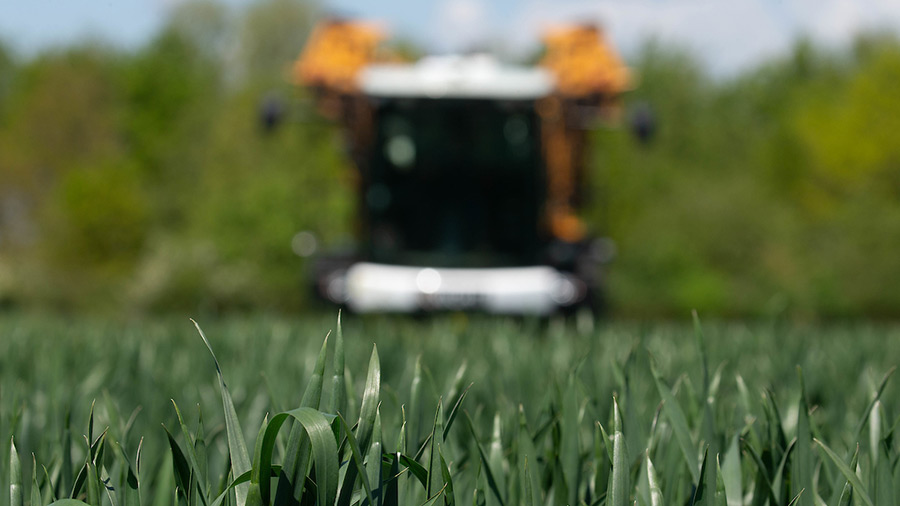Regenerative farming: Is there a place for fungicides?
 ©Tim Scrivener
©Tim Scrivener Regenerative farming systems can be used to minimise dependence on fungicides, but won’t exclude them completely.
While most of the growers who have adopted regenerative agriculture are aiming to cut back on inputs, there will be occasions when they must be used to get a good outcome, agree experts and farmers.
See also: Winter bean choices include market leader-beating variety
There’s also growing recognition that it’s important to combine all the tools available in a disease control strategy.
Cultural and chemical
How they are brought together will depend on the system, site and season – with actions then being matched to the situation, says Stuart Knight, director of crops and agronomy at Niab Tag.
He emphasises that cultural techniques are just as important as chemical ones.
“Growers can’t rely on fungicides, especially as we are losing key active ingredients and seeing performance declines among the remaining ones.
“Any farming system, whatever it is, will fail if it is over-reliant on one component.”
In the case of fungicides, it’s very difficult to grow high-yielding wheat crops consistently without them, as Kent farmer and consultant Andy Howard has found, especially when the system is in transition.
Mr Howard differentiates between the types of fungicides that might be used and how they are employed.
He believes foliar fungicides are still necessary on many regenerative farms, but seed treatments are less appropriate.
“Having encouraged the soil biology for the benefits that it brings, we don’t want to have a negative impact on it by using treated seed,” he says.
A farmer’s experience
Back in 2016, Mr Howard set an ambitious aim of reducing inputs by 50% in five years on his farm, while maintaining production.
In that time, he found it easier to reduce fungicides than herbicides and has cut fungicide spend down to about £45/ha this year.
His approach has been to start with biology and nutrition, before bringing in any fungicides.
This season that has meant that he didn’t need a T0 or T1, but he did use a reasonable T2 and a low rate T3.
Mr Howard also points out that using too much nitrogen makes it difficult to cut back on fungicides.
“Excess nitrogen drives disease and puts the emphasis on spraying. Those scenarios make it tricky to use fungicides as a last resort, not first, which is how it should be.”
While genetics have a role to play in reducing pesticide use, his advice is that they need to be used in the right system.
“We know that they will break down if they aren’t part of a whole farm approach – so we shouldn’t expect them to save a bad situation.”
He adds that the use of high fungicide rates drives the development of disease resistance, so he has reduced rates, with the help of biology and nutrition.
“The appropriate dose does change as the system evolves and matures. We have been able to cut rates successfully, so are now looking at reducing the frequency of sprays.”
Spring crops and intercrops – both of which are grown on his farm – need far less intervention. A bean/oat mix has reduced the amount of rust in the beans by as much as 75%.
“Variety blends are another opportunity,” he says. “They are a cheap way of bringing in diversity and have been very successful on a number of farms, both in terms of yield increases and lower disease levels.”
Andy Howard’s top tips for reducing fungicides
- Do the basics first – start by looking at your soils
- Investigate techniques such as variety blends, nutrition and intercropping, to reduce susceptibility to disease and introduce diversity
- Try out new approaches on small areas
- Scale up to 10ha to assess approach
Spraying regime
Niab’s Mr Knight highlights that there are unnecessary fungicide applications being made on farms, both in terms of the level of products in the mix and the use of extra top-up sprays.
“It comes back to matching the spray to what’s in front of you. The insurance mentality will have to change with lower input approaches.”
On spray rates, he says that high doses will select for resistant septoria strains.
“High rates cost money, so it’s important to be appropriate. Remember too – whatever fungicide regime you use, timing is key when it comes to getting good disease control.”
What about biostimulants?
Don’t be tempted to swap one cost for another when weaning yourself off fungicides, warns Syed Shah, regional agronomist at Niab.
There are alternatives, such as biostimulants, being marketed widely, many of which have a positive physiological effect on the crop, but few have given a yield difference in trials, he says.
However, they can’t be used to control the main foliar diseases once they’ve been identified in a crop, he warns.
“If you’ve got yellow rust or septoria to control, at the moment, you need a fungicide. Biostimulants and other biological products, on the other hand, usually need to be applied before disease comes in, as they work in a different way.”
He agrees that nutrition is important for a healthy plant, and recommends that growers concentrate on getting that right before cutting inputs.
“Sometimes you do have to use fungicides. The direction of travel is clear – reducing inputs is on everyone’s radar and it can be done. But don’t be in too much of a hurry if the weather is against you.”
Stuart Knight, director of crops and agronomy at Niab Tag, Syed Shah, regional agronomist with Niab, and Andy Howard, Kent farmer and consultant, were speaking at the Groundswell event on 22-23 June 2021 at Lannock Manor Farm, Hertfordshire.

